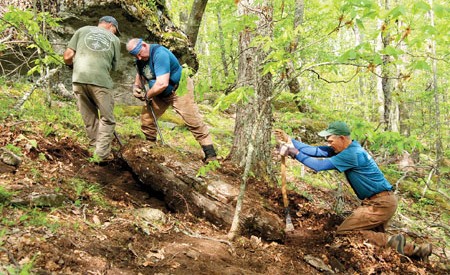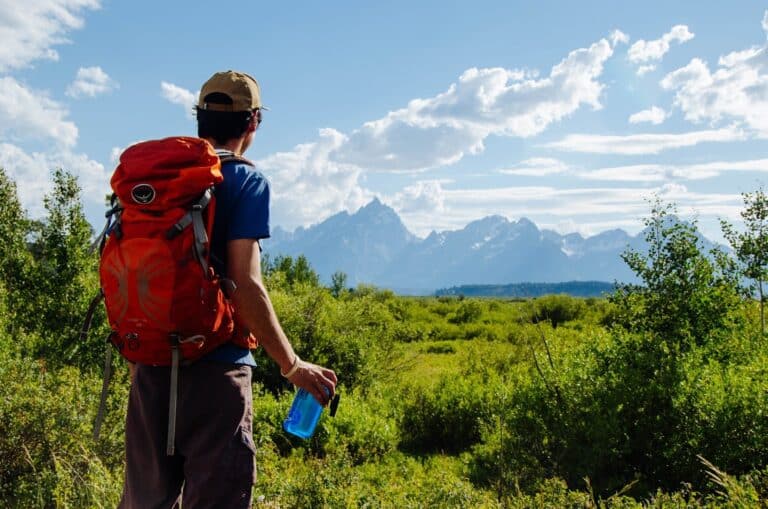Photo: Courtesy: Carolina Mountain Land Conservancy/Bearwallow Mountain
There’s a 50-mile trail system in the works for the Hickory Nut Gorge, a dramatic canyon on the edge of the Southern Appalachians 30 miles east of Asheville. The giant loop of singletrack will connect high elevation balds, rocky outcroppings with views of the Smoky and Black Mountains, swimming holes and trout streams, backcountry campsites, even a fire tower. It will be the thread that ties together the gorge, a chasm known for its dramatic rock features and world-class rock climbing. And it’s being built almost entirely on private property.
The Hickory Nut Gorge Trail Network (HNGT) is the brainchild of Peter Barr, trails coordinator for the Carolina Mountain Land Conservancy (CMLC), a non-profit that preserves land with private funding, then typically opens that land to the public, often building new trails with sweat equity donated by the Carolina Mountain Club. For the HNGT, the conservancy is looking beyond their own properties and buying public right-of-ways from private landowners throughout the gorge. The right-of-ways allow the conservancy to build a trail on private land while ensuring public access to the trail corridor forever, regardless of who owns the land.
“Getting this massive project off the ground is complicated, but it’s doable,” Barr says. “It starts with a few landowners who see their land as something so meaningful, they want to share it with others.”
While the 50-mile loop will take decades to complete, the first piece of singletrack is already on the ground, ascending Bearwallow Mountain. A 12-mile Upper Gorge loop that connects Bearwallow with nearby Forest Nature Preserve is currently in the works as well. The HNGT might be one of the most ambitious trail projects to be undertaken on private land in our region, but it’s certainly not the only instance of private conservations opening gates to hikers. As federal and state funding for public land continues to diminish, private land conservancies are shouldering the conservation and recreation responsibility more and more. And as many conservationists have learned over the years, the best way to garner public support and funds for a conservation project is to grant public access.
“If I can get someone to the top of Bearwallow Mountain, they’ll see why land conservancy is important,” Barr says. “Giving the public access makes the land relevant.”
Here are four private preserves in the Southern Appalachians that are ripe for some friendly trespassing.
Lula Lake
Lookout Mountain, Ga.
Just south of Chattanooga, the Lula Lake Land Trust preserves 4,400 acres of primo terrain on the edge of rocky Lookout Mountain. The core 500-acre property is packed with rocky outcroppings, a plunge pool with its own 30-foot cascade, a separate 85-foot waterfall, and six miles of doubletrack, all encased inside an impressive Cumberland Plateau escarpment. Lula Lake is only open on the first and last Saturdays of each month, but the property is worth the wait. Mountain bikers and trail runners should also check out Lula Lake’s other property on Lookout Mountain, which houses a piece of the Cloudland Canyon Connector Trail, a new 26-mile trail system open to fat tires that will eventually connect to Cloudland Canyon State Park, also on Lookout Mountain. lulalake.org
Bearwallow Mountain
Hickory Nut Gorge, N.C.
Bearwallow is the CMLC’s flagship trail project in the Hickory Nut Gorge and serves as the public right-of-way model as the group moves forward with the ambitious 50-mile network. Hike the mile-long trail up Bearwallow, a 4,232-foot high bald that sits on the Eastern Continental Divide, and you’ll understand the potential of the project. Bearwallow is still a family-owned property where cattle graze seasonally. From the top, you can see the Smokies, the Blacks, and into South Carolina. There’s also a firetower that Barr is trying to restore, which will offer views into the belly of Hickory Nut Gorge, taking in Chimney Rock and Lake Lure.
The Carolina Mountain Land Conservancy is so adamant about getting the public on their properties that they’ve created a hiking challenge, where hikers can earn gear and a patch just by treading through a series of trails on CMLC lands. carolinamountain.org
Pendergrass Murray Recreational Preserve
Red River Gorge, Ky.
This 750-acre tract of land in the southern end of the Red River Gorge is packed with quality sandstone cliffs and climbing routes. The Red River Gorge Climbers Coalition purchased the land in 2004 and is poised to make the last payment on the property this summer. Since acquiring the land, the group has developed a system of hiking and biking trails as well as almost 500 climbing routes that range from 5.6 to 5.14. Sign a waiver and make a donation (not mandatory, but it’s good karma) and the cliffs are yours to scale. For easier sport and a few trad routes, head to The Crossroads crag. If you want to see the best sport climbers in the country tackle some of the hardest routes in the Red, go directly to the Bob Marley crag, an amphitheater with very tall, very steep rock. rrgcc.org
Bottom Creek Gorge
Roanoke River, Va.
Owned by The Nature Conservancy, the Bottom Creek Gorge tract covers 1,650-acres of land at the headwaters of the Roanoke River. You’ll find virgin forests, wildflowers galore in the spring, and the second tallest waterfall in the state, the 200-foot Bent Mountain Falls. Roughly five miles of trail traverse the gorge. Seeing the falls is a must, but also take time to explore the remote virgin hemlock forest, as well as the half-acre shale barren which supports the rare chestnut lipfern, a plant that only lives in isolated patches in southwestern Virginia and eastern West Virginia. nature.org/virginia








